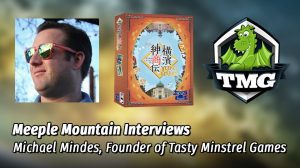Walnut Grove – Andy Matthews
When I first got started in the hobby, I came across Walnut Grove on BoardGameGeek. It was definitely more in-depth than what I was familiar with, but the theme and artwork seemed quaint and appealing. I always wanted to try it out, but never had the chance. Then recently I was able to trade a copy of Sriracha for Walnut Grove and finally try it out.
Walnut Grove is a tile laying and worker placement game in which players farm the land with workers you hire over the course of the game. Over 8 rounds you’ll expand your property—gathering milk, fish, lumber, ore, and grain. You also have the chance to head into town and hire more workers, buy materials to construct buildings, and buy and sell your bounty.
Walnut Grove is certainly a bit tighter than I was expecting. You’re constantly clawing and scraping to make sure you can feed your crew and keep them warm. And it feels like you have a hard time earning enough money to do more than just subsist. Because it’s a tile laying game, there’s a degree of luck involved in the tiles that you draw from the bag. Sometimes you get what you need, and other times you’ve just got to get by. I’m looking forward to trying it again though and living my best Little House on the Prairie life.
Ease of entry?:
★★★☆☆ – There were a few questions
Would I play it again?:
★★★★☆ – Would like to play it again
Read more articles from Andy Matthews.
The White Castle – Bob Pazehoski, Jr.
Regardless of the verdict, Devir games have demanded attention of late. The White Castle has drawn a lot of praise, including from our own Justin Bell (read Justin’s review here). The design team that brought us The Red Cathedral and 1987 Channel Tunnel has delivered another rock-solid title with this Japanese-set cruncher.
The White Castle draws strength from its variety. Players select and place one die on each of nine turns to gather resources, trigger actions, and otherwise unleash wicked combinations from any of several key areas of the board. Every actionable location in the game is defined by a card or token, guaranteeing unique experiences. Ironically, if I were to level a charge against the game, it would be the frequency of changes during play. The sheer number of icons is overwhelming for first-time players, and the fact that some might change from turn to turn (especially at higher player counts) rules out the possibility of growing attached to any specific plans.
That being said, The White Castle is a fantastic play. Despite the dearth of information and the changing landscape, the iconography is clean for easy digestion and a swift path to fluency. The board offers choices upon choices. If you like chains of activity, you will want to table this one soon. Every turn involves a bit of calculation to determine the most enticing combo sequence, but the result is almost always a sense of accomplishment. I pulled off a respectable score in the loss, but the better testimony was looking back over how much happened in so few turns. It’s the sort of game you’ll want to shuffle up and play again right away.
Ease of entry?:
★★★☆☆ – There were a few questions
Would I play it again?:
★★★★★ – Will definitely play it again
Read more articles from Bob Pazehoski, Jr.
Workshop Tonttu – David McMillan
It’s springtime, and what better way to celebrate than with a Japanese card game about elves working in Santa’s workshop? Okay, if you’re wondering why I’m talking about a Christmas game in the middle of March, rest assured: I am just as confused as you are. I have no idea why this was the go-to game of choice at a recent game night, but here we are.
Workshop Tonttu is a card drafting game in which the players are trying to acquire the materials needed to construct the toys printed on the cards in the middle of the table. Each player starts the round with a handful of resource cards in their hand and two resources on their workbench. Each round, players place a card from their hand into their workbench area, and then they compete to complete the requirements of one of the toy cards in the central area between the players. If multiple players choose the same card, then they compete even further, throwing resources at the card until one player emerges victorious or both just give up. Then, the players split the cards remaining in their hands and divide them up between their neighbors. After that, a new round begins. At the end of the game, players receive points based on how many different types of toys they made and how many of each specific type.
Despite the few inevitable hiccups that came along with the rough English translation of the game (not to mention the weird timing), I had a pretty good time with this one. Is it my favorite game ever? No. Would I play it again? Probably, if there was nothing else going on.
Ease of entry?:
★★★☆☆ – There were a few questions
Would I play it again?:
★★☆☆☆ – Would play again but would rather play something else
Read more articles from David McMillan.
Splendor Duel – K. David Ladage
Two things before I begin: (1) I love Splendor. I have the game and the expansions. My wife and I have played many games at all player counts using each of the expansion setups. (2) It is my opinion that Splendor plays perfectly well as a two, three, or four player game.
That second point is quite relevant here. When I first heard about Splendor Duel, my first reaction was: why? I have several ‘duel’ versions of games in my collection that make perfect sense. For example, 7 Wonders is a great game that does not handle two-players well, so 7 Wonders Duel makes perfect sense (and has become a beautiful, independent experience all its own). So what does Splendor Duel offer? In my opinion: not a damn thing.
So much of the game appears to be changes for the sake of making changes; added complexity for the sake of adding complexity. The artwork is a downgrade from the beauty of the original and replaces it with a style that looks like Kingsburg devoid of joy or whimsy. I could go on and on but let me just say this: if you want a beautiful two-player Splendor experience, play Splendor with two players. Do not waste your time on this… thing.
Ease of entry?:
★★★☆☆ – There were a few questions
Would I play it again?:
☆☆☆☆☆ – No chance
Read more articles from K. David Ladage.
The Key: Escape from Strongwall Prison – Justin Bell
My love affair with the deduction game series The Key is well documented. The Key: Escape from Strongwall Prison is my fifth box (I think this means I have played all of them!), and at this point, it is pretty easy to summarize my thoughts.
Strongwall Prison uses a fun premise—this game built around the criminals that you caught in all the other games from The Key universe. Some of these criminals have broken out of the joint, and have accomplices who helped with their escape and their hideouts. Not only do players have to figure out how each criminal broke out of Strongwall, but who helped them along the way plus other key facts using some of the hardest puzzles from the series.
My family took Strongwall Prison for a spin recently and it was a very tough ride. My kids, now aged 10 and 7, literally gave up after beginning to sort through both the large clue cards (standard for the series) and a new smaller series of cards to pursue the second part of the game’s deduction puzzle. Even I have to admit that Strongwall Prison definitely earns its stripes as the “Level 3–Expert” rating on the front of the box. This felt much harder than the four previous games. For gamers, or families who really have exhausted easier puzzle games in their collection, Strongwall Prison is worth a look. The series designer, Thomas Sing, continues to work magic beyond The Crew: The Quest for Planet Nine and The Crew: Mission Deep Sea, the best co-operative trick-taking games ever made.
Ease of entry?:
★★★☆☆ – There were a few questions
Would I play it again?:
★★★☆☆ – Wouldn’t suggest it, but would happily play it
Read more articles from Justin Bell.














Add Comment